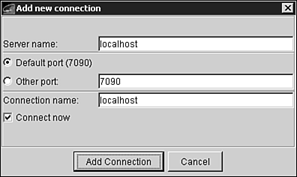| With the release of the WebLogic Server 7, the server lifecycle has been greatly improved to allow WebLogic Server to exist and transition between one of several states, as illustrated in Figure 10.21. Figure 10.21. The WebLogic Server lifecycle.  The behavior of each state shown in Figure 10.22 is as follows : Figure 10.22. Connect the JRockit Management Console to the JRockit JVM.  -
STARTING This transition progresses through the following steps: -
An Administration Server retrieves its configuration information (including security configuration data) from the domain's configuration files. Alternatively, a Managed Server communicates with its associated Administration Server for its configuration and security data. -
WebLogic Server starts its kernel-level services, which includes logging and timer services. -
WebLogic Server, using the retrieved configuration information, then initializes its subsystem-level services, such as the Web and EJB containers, RMI, JNDI, JDBC, and security. -
WebLogic Server deploys the application modules to their respective containers. -
WebLogic Server executes any configured startup classes. -
STANDBY In this state, WebLogic Server has initialized all of its services and applications and can accept administration commands and participate in cluster communication. However, it is not accessible for requests that come from external clients , except administration requests. From the STANDBY state, you can quickly resume WebLogic Server's ability to process client requests.  This state is only applicable if you have configured the domain to use an administration port. For a discussion of this, see "Enabling the Administration Port," p. 801 . This state is only applicable if you have configured the domain to use an administration port. For a discussion of this, see "Enabling the Administration Port," p. 801 .
-
RUNNING In this state, WebLogic Server is fully functional and fully manageable, offering its services to clients and operating as a full member of the cluster. -
SHUTDOWN In this state, WebLogic Server is configured, but does not exist as a process. You can transition WebLogic Server into this state either from the RUNNING state or the STANDBY state. As it transitions to SHUTDOWN, a server goes through the SHUTTING DOWN state. When you issue a graceful shutdown, WebLogic Server first transitions itself to a transient state, SUSPENDING and rejecting new work but enabling in-flight work to complete. WebLogic Server then provides time to each subsystem-level service to release its external resources before it is shut down. Note You can shut down a server gracefully only from the RUNNING or STANDBY states.
When you issue a forceful shutdown, the server notifies all applications and subsystems to abort all relevant in-flight work immediately and release remaining resources where applicablefor example, closing files and network connections. This is the quickest way to shut down WebLogic Server, but could result in rolled back transactions and session loss for some clients. Note You can shut down a server forcefully from any state.
-
FAILED WebLogic Server can transition to this state if one or more critical services become dysfunctional during the lifetime of server. Your only option to recover from the FAILED state is to shut down the server. -
UNKNOWN WebLogic Server can transition to this state if it does not respond to requests (Administration or client). Further investigation is required to determine the reason for this UNKNOWN state before it is shut down as the reason could be because the server is very busy processing requests. You can control WebLogic Server's lifecycle by choosing Server, Control, Start/Stop in the Administration Console or via the weblogic.Admin utility in conjunction with the following commands:  To learn how to use these weblogic.Admin commands, see "The weblogic.Admin Utility Commands," p. 368 . To learn how to use these weblogic.Admin commands, see "The weblogic.Admin Utility Commands," p. 368 .
With these new server lifecycle states, WebLogic Server can be brought up quickly in a Hot Standby state and be primed for quick activation in the case of an outage . Also, WebLogic Server can be gracefully suspended , allowing new work requests to be rejected, while in-flight requests are allowed to complete. |


 This state is only applicable if you have configured the domain to use an administration port. For a discussion of this,
This state is only applicable if you have configured the domain to use an administration port. For a discussion of this,